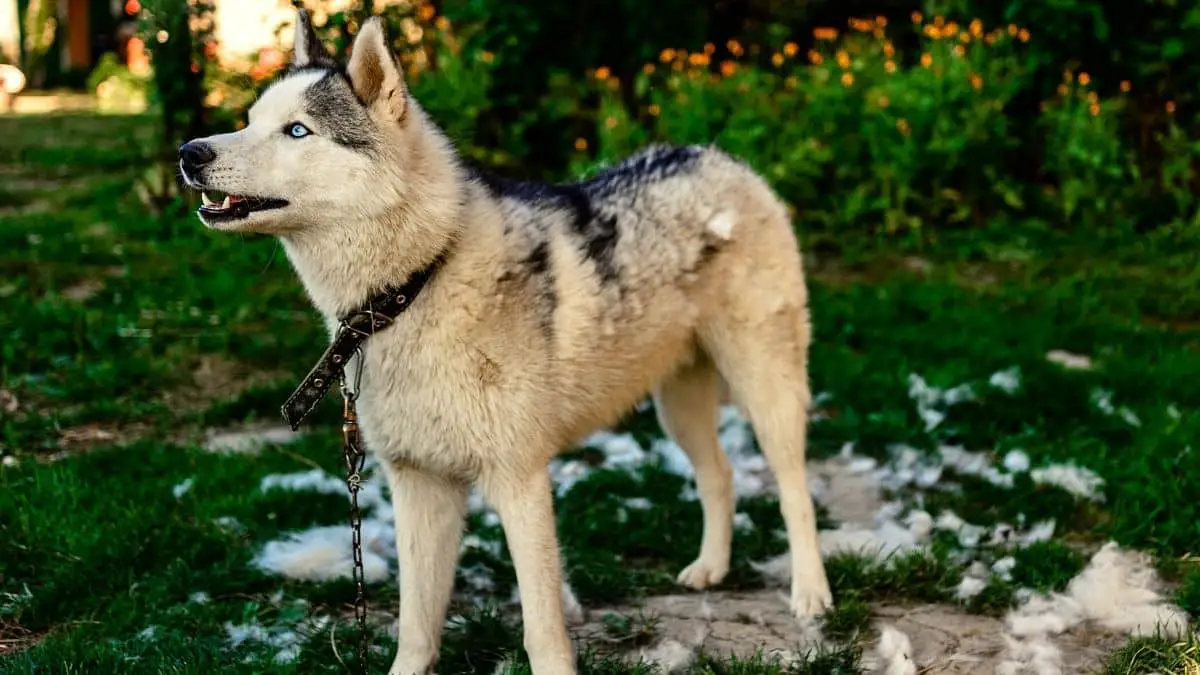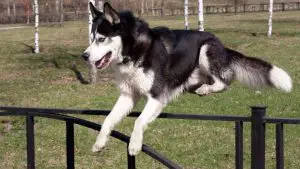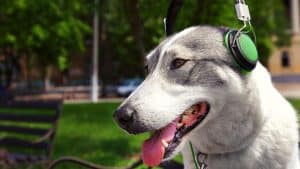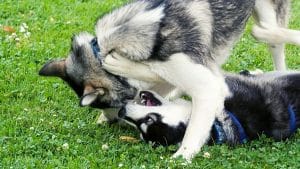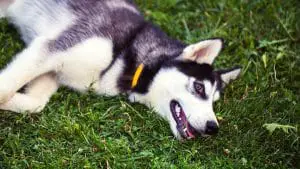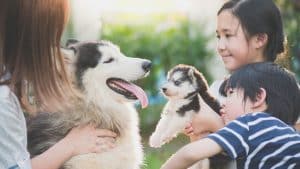Huskies and Shedding: 9 Things You Should Know
Siberian Huskies, with their distinctive look and stunning blue eyes, are quite affectionate and sharp. They make a great addition to your home.
This dog breed features an impressive coat that keeps them warm against the cold, harsh weather conditions. While this may be good for them, it is not the best of news for Huskies owners. Siberian Huskies tend to shed a lot. They lose their coat one or two times a year, depending on the season. This ‘blowout’ goes on for about a couple of weeks.
In this write-up, you will learn more about Huskies and their shedding and how to take care of this issue. So, without further ado, let’s dive right in.
Table of Contents
The History of a Husky
Before you delve deep into this article, it is important to know the background of a Siberian Husky.
Huskies are sled dogs that originated from the cold regions of Siberia. In places like this, the temperature can drop considerably during summer as well. Siberian Huskies are quite energetic and love to play outdoors all the time. With that said, these dog breeds need to exercise regularly, i.e., two times daily. A short run to the park is not going to be enough to keep your Husky physically fit and in good health.
Huskies and Their Double-Coat
Siberian Huskies, in general, have dense double coats. The outer fur holds off the water, harmful sun rays, insects, etc. The undercoat aids in maintaining the temperature of their skin.
These coats also keep your Husky safe against any external injuries. Not only that, because they are from a cold region, the thick fur is to protect them against the harsh winter.
In regards to their colors, Huskies come in a wide range of colors with different markings. Nevertheless, you will find most of their faces with patterns, white paws, and legs, as well as white-tip tails.
When Does a Husky Shed?
As I have mentioned before, your Husky will go through the ‘blowout’ process twice every year ahead of any season change.
Most of the time, they blow their undercoat once winter passes. In this way, they prepare for the nearing summer season and once more prior to the beginning of winter.
Every once in a while, however, huskies tend to shed only once a year. This factor often depends on the location and weather, or maybe your furry companion is just one of a kind.
If you live in a place where the weather is relatively warm, your Husky will blow their fur constantly and quite excessively.
How Long Does a Husky Shed For?
Are you worried thinking how long you’re going to have to clean the fur your Husky leaves in its wake? Well, let me make things clearer for you, so you’re prepared for what’s to come.
Normally, a Husky sheds its dead fur for over three to five weeks. Depending on certain circumstances, some Huskies may be through with the process earlier than expected, and for others, an extended period.
Rest assured, there are numerous approaches you can try for a proper blowout when your Husky starts to shed.
Let’s discuss some of those useful steps and make sure you are well-informed on how to take care of the shedding. Do bear in mind that you cannot stop blowouts or rush the process; therefore, it is wise to remember these guidelines.
How to Take Care of Husky Shedding
The excess blowouts of a Husky are natural and cannot be avoided. Nevertheless, there are methods you can follow to decrease the amount of fur and keep your home fur-free.
Here are some effective ways to take care of Husky shedding:
- Avoid cutting or shaving a Husky’s coat
- Brush regularly
- Giving your Husky a bath
- Provide a nutritious diet
- Exercising
Below, I’ll be explaining further on each tip, so you’ll be fully prepared as your Husky undergoes the shedding process.
Avoid Cutting or Shaving a Husky’s Coat
Dog breeds such as Huskies have double coatings, which you need to avoid shaving. Shaving the coat does not put an end to shedding.
Not only that, when you shave such dog breeds, tangled fur becomes the major issue. This is because the coat inside tends to outgrow the top coating, which leads to a messy matting of the double-layered hair.
Matting prevents a Husky’s body temperature from regulating naturally. This eventually will lead to your dog overheating due to the absence of air gaps in the new-grown coat.
Huskies originate from a colder region. Hence, summer heats are torture for them, and matting does not help at all in keeping them cool.
According to My Happy Husky, the topcoat of a Husky helps protect them against direct heat as well as severe UV rays. It also makes sure insects do not reach their skin. Having said all this, you may want to reconsider shaving your Husky.
Brush Regularly
Brushing your Husky’s coat regularly plays an essential role in minimizing the shedding of dead fur. Their body remains cool when you remove this excess hair and even helps in the stimulation of new hair development.
Petco suggests that you need to groom your Husky two or three times weekly in order to maintain a healthy coat. Any more than this, and it will end up irritating their skin.
For some pet owners, brushing their furry companion does not come easy. I can attest to that as I sometimes struggle with my adorable yet mischievous partner as well.
Having said that, there are ways you can go about reintroducing the brush to them. This way, your Husky can improve their relationship with it and, in return, no more stress for you.
For one, how about giving him a treat after every brushing session? Doing as such will get your dog more associated with his brush in an instant. Eventually, your Husky will no longer resist or fuss over being brushed.
Giving your Husky a Bath
While there are de-shedding shampoos that also do their work, organic ones are always the best option for your Husky. I highly suggest you get shampoos that are specifically and naturally made to treat their shedding.
This dog breeds’ hair is clean and produces less oil. Therefore, you don’t need to give your dog a bath frequently. One bath in 3 to 4 months is enough to keep them clean.
Bathing your furry friend properly greatly helps in removing excess hair. Nevertheless, you need to keep in mind that giving them a bath repeatedly will dry their skin. This, as you may have figured, is not good for your Husky.
When it’s time for your Husky to shed, you can give them extra bathing. Doing so stimulates the shedding and aids in loosening their fur that needs removing.
I recommend you use grooming brushes when bathing your dog, as this also helps to untangle their hair.
Provide Nutritious Diet
Depending on the well-balanced diet you provide your dog, it will help in the development of their skin as well as their fur. Feeding nutritious meals will make them stronger and improve their overall health.
Not looking after your Husky’s nutrition properly will, in no way, ease the blowout process.
Shedding does occur due to seasonal or climatic changes; however, not feeding sufficient nutrition affects them as well.
Another reason for shedding is also due to allergies. From what I’ve learned so far, most Huskies have a weak digestive system which leads to upset tummies and disagreeing with various foods.
There are numerous dog foods that have ingredients that cause allergic reactions in Huskies. So, you need to look out for these things to keep your dog safe.
Bear in mind that allergies can cause drying of their skin and, in turn, form dandruff on their scalp. This will eventually lead to their hair becoming frail and shedding a lot.
Exercising
Huskies require constant workouts. One hour two times on a daily basis is strongly recommended to keep your Husky fit as well as assist their shedding.
When the blowout season approaches, make sure your dog gets the additional runs it needs. How this helps is it releases the dead hair, making it easy to remove them.
Exercising will keep your Husky’s well-being in good condition. Always remember that good health plays a vital role in an efficient and proper shedding process.
Conclusion
Now that you have reached the end of this guide, I hope my information on Huskies and shedding did you justice.
In conclusion, do bear in mind that you need to learn how the shedding process works properly. In addition to that are the techniques you can try to assist before and throughout your Husky’s blowout.
Once you choose a Husky as your pet, you no longer will be able to live in a fur-free home. All there’s left for you to do is follow the guidelines above, and I assure you that you will see the changes.
The shedding process is vital for Huskies, so make sure you help yours by knowing everything there is to it.

